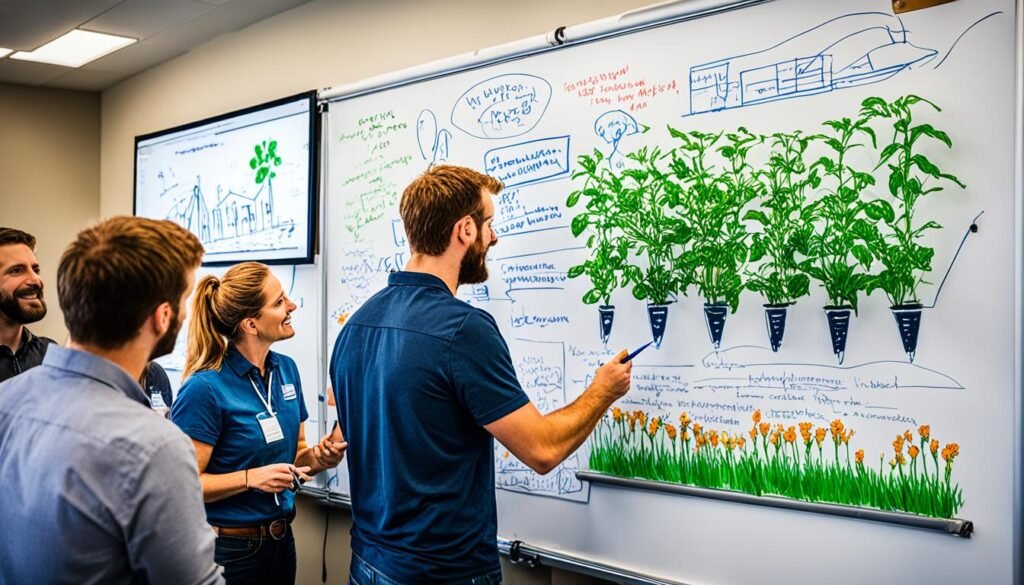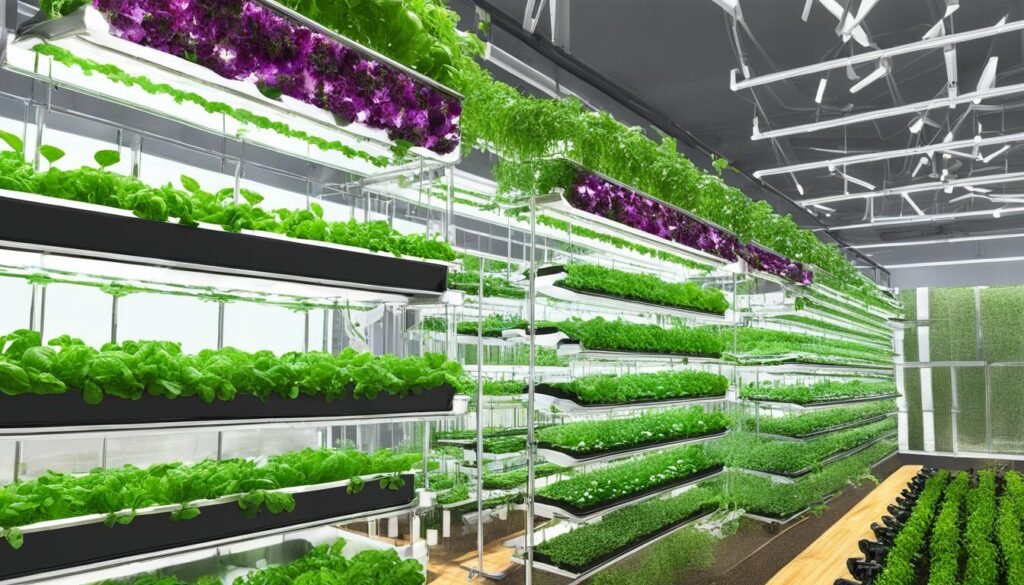In the pursuit of sustainable agriculture, a groundbreaking concept is emerging that combines the power of equines with the efficiency of hydroponic farming systems. Introducing the innovative approach of developing horse-driven mechanisms for hydroponic farming.
This revolutionary idea aims to harness the natural strength and energy of horses to drive and power hydroponic systems, creating a eco-friendly and efficient agricultural solution.
By leveraging the equine power, this innovative farming technique seeks to address the pressing need for sustainable agriculture solutions that can meet the growing demand for food production while minimizing the environmental impact.
Through the integration of horse-driven mechanisms and hydroponic systems, this approach promises to revolutionize the way we approach vertical farming and alternative energy sources for agriculture.
As the world continues to grapple with the challenges of climate change and resource scarcity, the exploration of animal-powered machinery and eco-friendly farming methods has become increasingly crucial.
This article delves into the intricate details of this innovative farming technique, showcasing the potential for mechanized farming solutions that harness the power of equines to drive hydroponic systems and revolutionize the future of sustainable agriculture.
Introduction to Horse-Driven Mechanisms for Hydroponic Farming
As the world grapples with the pressing need for sustainable agriculture solutions, the potential of harnessing the power of equines to drive hydroponic farming systems has gained significant attention.
Equines, with their remarkable strength, endurance, and compatibility with agricultural tasks, offer a promising alternative to traditional energy-intensive farming methods.
The Need for Sustainable Agriculture Solutions
The global population is rapidly growing, and the demand for food is increasing exponentially. Conventional farming practices, often reliant on fossil fuels and energy-intensive machinery, have contributed to environmental degradation and the depletion of natural resources.
To address this challenge, the agricultural sector must embrace eco-friendly farming methods that prioritize sustainability and minimize the carbon footprint.
Harnessing the Power of Equines
Equines, such as horses, possess unique characteristics that make them well-suited for powering hydroponic farming systems.
Their muscular build, endurance, and natural inclination towards agricultural tasks can be harnessed to drive various mechanisms, including pumps, conveyors, and other machinery needed for hydroponic cultivation.
By leveraging this animal-powered approach, farmers can reduce their reliance on fossil fuels and explore alternative energy sources for agriculture.
| Benefits of Horse-Driven Hydroponic Systems | Challenges |
|---|---|
| Sustainable and eco-friendly Reduced carbon footprint Cost-effective alternative to fossil fuel-powered machinery Utilizes the natural strength and endurance of equines | Requires specialized knowledge of equine behavior and needs Integration of safety features to protect both humans and animals Coordination and training of horses for specific farm tasks |
By exploring the potential of horse-driven mechanisms for hydroponic farming, the agricultural sector can pave the way for a more sustainable and eco-friendly future, harnessing the power of equines to revolutionize the way we approach food production.
The Benefits of Horse-Driven Hydroponic Systems
Integrating horse-driven mechanisms with hydroponic farming presents a range of compelling benefits that address the growing need for sustainable agriculture solutions.
This innovative approach not only enhances eco-friendly farming practices but also drives efficient crop production and enables vertical farming techniques.
One of the primary advantages of horse-driven hydroponic systems is their sustainability. By harnessing the power of equines, these systems reduce the reliance on fossil fuels and electricity, significantly lowering the carbon footprint of agricultural operations. This aligns with the growing demand for sustainable agriculture and eco-friendly farming methods.
Moreover, the use of horse-powered mechanisms can improve the efficiency of crop production. Horses are capable of generating mechanical energy to power various components of the hydroponic system, such as water pumps and nutrient distribution systems.
This results in a more reliable and consistent supply of essential resources for plant growth, leading to enhanced yields and better-quality produce.
- Improved sustainability and reduced environmental impact
- Enhanced efficiency in crop production and nutrient delivery
- Enabling of vertical farming techniques for increased yield per square foot
- Reduced reliance on fossil fuels and electricity
- Alignment with the growing demand for eco-friendly farming solutions
The integration of horse-driven hydroponic systems also opens up the possibility of vertical farming, a revolutionary approach that maximizes limited space and resources. By leveraging the power of equines to operate the various components of the hydroponic system, farmers can stack growing trays vertically, significantly increasing the yield per square foot of land.
This makes horse-driven hydroponic systems an attractive option for urban and peri-urban agriculture, where land availability is often limited.
In summary, the benefits of horse-driven hydroponic systems extend beyond just sustainable agriculture. They offer a comprehensive solution that addresses the growing demand for efficient, eco-friendly, and space-conscious farming methods, making them a valuable asset in the pursuit of a more resilient and environmentally responsible food system.
Designing Horse-Powered Mechanisms
Developing effective horse-powered mechanisms for hydroponic farming requires a deep understanding of equine behavior and needs.
By carefully designing systems that cater to the comfort and well-being of the animals, we can harness their natural strength and endurance to power our mechanized farming solutions.
Understanding Equine Behavior and Needs
Horses are intelligent, social animals with unique behavioral patterns and physical requirements. Successful integration of horse-powered mechanisms begins with a thorough understanding of these characteristics.
Factors such as herd dynamics, feeding habits, and environmental preferences must be taken into account to ensure the horses’ optimal performance and overall health.
Integrating Safety Features
Safety is of paramount importance when designing horse-powered mechanisms for hydroponic farming. Integrating features that protect both the animals and human operators is crucial.
This may include the use of well-designed harnesses, failsafe braking systems, and ergonomic controls that minimize the risk of injury or accidents.
Prioritizing safety not only safeguards the wellbeing of all involved but also enhances the overall efficiency and reliability of the mechanized farming solution.

By carefully considering the unique needs of horses and incorporating robust safety features, we can unlock the full potential of animal-powered machinery in the pursuit of sustainable and efficient hydroponic farming.
This holistic approach ensures the welfare of the animals while delivering reliable and innovative mechanized farming solutions.
Developing Horse-Driven Mechanisms for Hydroponic Farming
As the demand for sustainable and innovative farming solutions grows, the concept of horse-driven mechanisms for hydroponic farming has gained significant attention. This approach combines the power and versatility of equines with the efficiency of hydroponic systems, offering a unique and eco-friendly alternative to traditional mechanized farming.
The development of horse-driven mechanisms for hydroponic farming involves a meticulous process that addresses various aspects, from system design to equine integration. The key focus is on creating a seamless integration between the animal-powered machinery and the hydroponic growing systems, ensuring maximum productivity and efficiency.
Designing Versatile Horse-Powered Systems
One of the primary challenges in developing horse-driven mechanisms is designing a system that can effectively harness the power of equines while maintaining the specific requirements of hydroponic farming. This involves careful consideration of the following elements:
- Specialized traction and pulling mechanisms compatible with hydroponic setups
- Customized attachments for tasks like planting, harvesting, and maintenance
- Ergonomic and comfortable harnesses to ensure the well-being of the horses
- Integrated safety features to protect both the animals and the farmers
By addressing these design elements, innovators in the field are able to create horse-driven mechanisms that can seamlessly integrate with hydroponic farming techniques, delivering a sustainable and efficient solution.
Overcoming Challenges with Innovative Approaches
The development of horse-driven mechanisms for hydroponic farming is not without its challenges. Integrating the needs of the animals with the specific requirements of hydroponic systems requires a deep understanding of both domains.
Innovative approaches, such as leveraging advanced sensor technologies and data-driven optimization, have been instrumental in overcoming these hurdles.
By continuously refining and improving the design of these horse-driven mechanisms, the agricultural industry is poised to reap the benefits of this sustainable and animal-friendly farming solution, paving the way for a more eco-conscious future in hydroponic cultivation.
Exploring Different Hydroponic Growing Systems
As we delve into the world of horse-driven hydroponic farming, it’s crucial to understand the various growing systems that can be integrated with this innovative approach.
Two prominent techniques that stand out are the Nutrient Film Technique (NFT) and the Deep Water Culture (DWC) systems.
Nutrient Film Technique (NFT)
The Nutrient Film Technique, or NFT, is a hydroponic system that utilizes a shallow stream of nutrient-rich water to nourish the plant roots. This method is known for its efficient use of water and nutrients, making it an attractive option for horse-powered hydroponic farming.
The continuous flow of the nutrient solution ensures that the plants receive a constant supply of the essential elements they need to thrive.
Deep Water Culture (DWC)
Deep Water Culture, or DWC, is another highly effective hydroponic system that can be seamlessly integrated with horse-driven mechanisms. In this method, the plant roots are submerged in a nutrient-rich solution, allowing them to absorb the necessary nutrients directly from the water.
The deep water environment provides a stable and consistent environment for the plants, promoting rapid growth and efficient crop production.
Both the Nutrient Film Technique and Deep Water Culture systems offer unique advantages for horse-powered hydroponic farming. By understanding the intricacies of these growing methods, farmers can optimize their operations, ensuring a bountiful harvest while adhering to sustainable and eco-friendly practices.
Incorporating Vertical Farming Techniques
The future of sustainable agriculture lies in the harmonious integration of innovative techniques. One such approach that holds immense potential is the marriage of horse-driven mechanisms and vertical farming.
By harnessing the power of equine muscle and the efficiency of vertical growing systems, we can revolutionize the way we produce crops, paving the way for a more eco-friendly and productive future.
Vertical farming, with its ability to maximize limited space, offers a compelling solution to the challenges faced in traditional farming. When combined with the versatility and strength of horse-driven mechanisms, the possibilities for hydroponic farming become truly boundless.
This synergistic approach not only enhances the overall yield but also reduces the environmental impact, making it a prime choice for those committed to sustainable agriculture.
The integration of vertical farming techniques with horse-powered hydroponic systems presents a multitude of advantages:
- Efficient Crop Production: By stacking growing tiers vertically, the available land area is utilized to its full potential, leading to a significant increase in the number of crops produced per square foot.
- Enhanced Sustainability: The horse-driven mechanisms, powered by the natural energy of these majestic animals, minimize the carbon footprint associated with traditional farming methods that rely on fossil fuels.
- Reduced Water Consumption: Hydroponic farming, when combined with vertical growing systems, drastically reduces the amount of water needed for cultivation, promoting water conservation and environmental stewardship.
- Diversified Crop Selection: The versatility of vertical farming allows for the cultivation of a wider range of crops, catering to the diverse needs and preferences of consumers.
| Vertical Farming Technique | Benefit |
|---|---|
| Nutrient Film Technique (NFT) | Efficient use of space, reduced water consumption, and optimal nutrient delivery |
| Deep Water Culture (DWC) | Simplified system design, excellent oxygenation, and consistent nutrient supply |
By embracing the synergy between horse-driven mechanisms and vertical farming techniques, we can unlock new frontiers in hydroponic farming, paving the way for a more sustainable and productive agricultural future.

Equine-Friendly Living Quarters and Care
In the context of sustainable hydroponic farming, ensuring the well-being of the horses that power the system is of utmost importance.
From stable design to nutritional and healthcare requirements, every aspect of the equine-friendly living quarters must be carefully considered to promote animal welfare and optimal performance.
Stable Design Considerations
The design of the horse stables plays a critical role in creating a comfortable and safe environment for the animals. Key factors to consider include adequate space, proper ventilation, and the incorporation of natural elements. Stalls should be spacious enough to allow the horses to move freely, with sufficient bedding to cushion their movements.
Ventilation systems should maintain a comfortable temperature and humidity level, while also promoting air circulation to minimize the build-up of harmful gases.
Nutritional and Healthcare Requirements
Providing a balanced and nutritious diet is essential for the health and well-being of the horses. A team of equine nutritionists and veterinarians should work closely with the farmers to develop a comprehensive feeding plan that meets the specific needs of the animals.
This may include a combination of high-quality hay, grains, and supplements to ensure optimal energy, protein, and mineral intake. Regular veterinary check-ups, hoof care, and vaccination schedules are also crucial to maintain the horses’ overall health and prevent the spread of diseases.
| Stable Design Elements | Nutritional Requirements |
|---|---|
| Spacious stalls Proper ventilation Natural elements Cushioned bedding | High-quality hay Balanced grains Necessary supplements Customized feeding plan |
By prioritizing the equine-friendly living quarters and comprehensive care, the hydroponic farming system not only ensures the well-being of the horses but also promotes sustainable agriculture practices that align with animal welfare standards.
Training Horses for Hydroponic Farm Work
Integrating horses into the world of hydroponic farming presents unique challenges, but with the right training techniques, these majestic creatures can become invaluable assets to sustainable agricultural solutions.
Harnessing the power and adaptability of equines is a key component in developing animal-powered machinery for hydroponic systems.
Fundamental to this process is understanding the nuanced behaviors and needs of horses. Equine experts work closely with farmers to devise training programs that address the animals’ physical and psychological requirements, ensuring their comfort and safety while maximizing their efficiency within the hydroponic environment.
Targeted Training Strategies
- Acclimatization: Gradually introducing horses to the sights, sounds, and smells of the hydroponic farm, helping them feel at ease in the unfamiliar setting.
- Obstacle Navigation: Teaching horses to navigate the complex layout of hydroponic systems, walking between rows, and maneuvering around equipment with precision.
- Equipment Handling: Training horses to interact with the specialized machinery they will be powering, such as water pumps, grow beds, and harvesting tools.
- Behavioral Cues: Establishing clear communication through the use of voice commands, body language, and positive reinforcement to guide the horses’ actions.
By investing in the comprehensive training of horses for hydroponic farm work, farmers can unlock the immense potential of these animals as sustainable, eco-friendly, and cost-effective alternatives to mechanized solutions. The seamless integration of equine power and hydroponic technology promises to revolutionize the future of modern agriculture.
| Training Aspect | Key Objectives |
|---|---|
| Acclimatization | Helping horses feel comfortable and at ease in the hydroponic farm environment |
| Obstacle Navigation | Teaching horses to move safely and efficiently through the complex layout of hydroponic systems |
| Equipment Handling | Training horses to interact with and power the specialized machinery used in hydroponic farming |
| Behavioral Cues | Establishing clear communication and guidance through voice commands, body language, and positive reinforcement |
Eco-Friendly and Sustainable Practices
Embracing eco-friendly and sustainable practices is essential when integrating horse-driven hydroponic farming into your agricultural operations.
By implementing effective waste management strategies and water conservation methods, you can minimize the environmental impact and enhance the long-term viability of this innovative approach to sustainable agriculture.
Waste Management Strategies
Thoughtful waste management is crucial in maintaining the ecological balance of your horse-driven hydroponic farm. Implement composting systems to repurpose organic waste, such as horse manure and plant matter, into nutrient-rich fertilizer for your hydroponic growing beds.
This not only reduces landfill contributions but also closes the loop, ensuring a circular flow of resources within your farming ecosystem.
Water Conservation Methods
Water is a precious resource, and maximizing its efficient use is paramount in hydroponic farming. Incorporate advanced irrigation techniques, such as drip systems and rainwater harvesting, to minimize water consumption and reduce waste.
Additionally, explore the use of water recirculation systems that allow for the reuse of nutrient-rich water, further enhancing the sustainability of your horse-driven hydroponic operation.
FAQ
What are the key benefits of using horse-driven mechanisms for hydroponic farming?
The primary benefits of using horse-driven mechanisms for hydroponic farming include enhanced sustainability, reduced environmental impact, improved crop yields, and the ability to implement vertical farming techniques.
By harnessing the power of equines, this approach offers an eco-friendly and efficient alternative to traditional farming methods.
How do you design horse-powered mechanisms for hydroponic systems?
Designing horse-powered mechanisms for hydroponic farming requires a deep understanding of equine behavior and needs. It is crucial to integrate safety features that protect both the horses and the human operators.
The mechanisms must be tailored to the specific requirements of the hydroponic growing system and the capabilities of the equines.
What types of hydroponic growing systems can be used with horse-driven mechanisms?
The two main hydroponic growing systems that can be integrated with horse-driven mechanisms are the Nutrient Film Technique (NFT) and the Deep Water Culture (DWC). Both systems can be optimized to work seamlessly with the horse-powered mechanisms, leveraging the animal’s strength and energy to power the hydroponic farming operations.
How do you ensure the well-being of the horses in a hydroponic farming system?
Prioritizing the well-being of the horses is crucial in a horse-driven hydroponic farming system. This involves providing equine-friendly living quarters, with careful consideration given to stable design, as well as meeting the horses’ nutritional and healthcare requirements.
Proper training and understanding of equine behavior are also essential to ensure the animals’ comfort and optimal performance.
What are the key eco-friendly and sustainable practices associated with horse-driven hydroponic farming?
Eco-friendly and sustainable practices play a crucial role in horse-driven hydroponic farming. These include implementing effective waste management strategies and water conservation methods to minimize the environmental impact of the system.
By embracing these practices, the horse-driven hydroponic farming approach can further enhance its sustainability and contribute to a more environmentally-responsible agricultural model.

